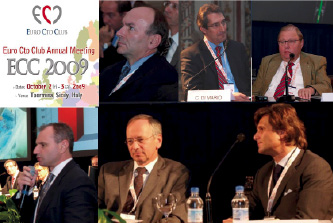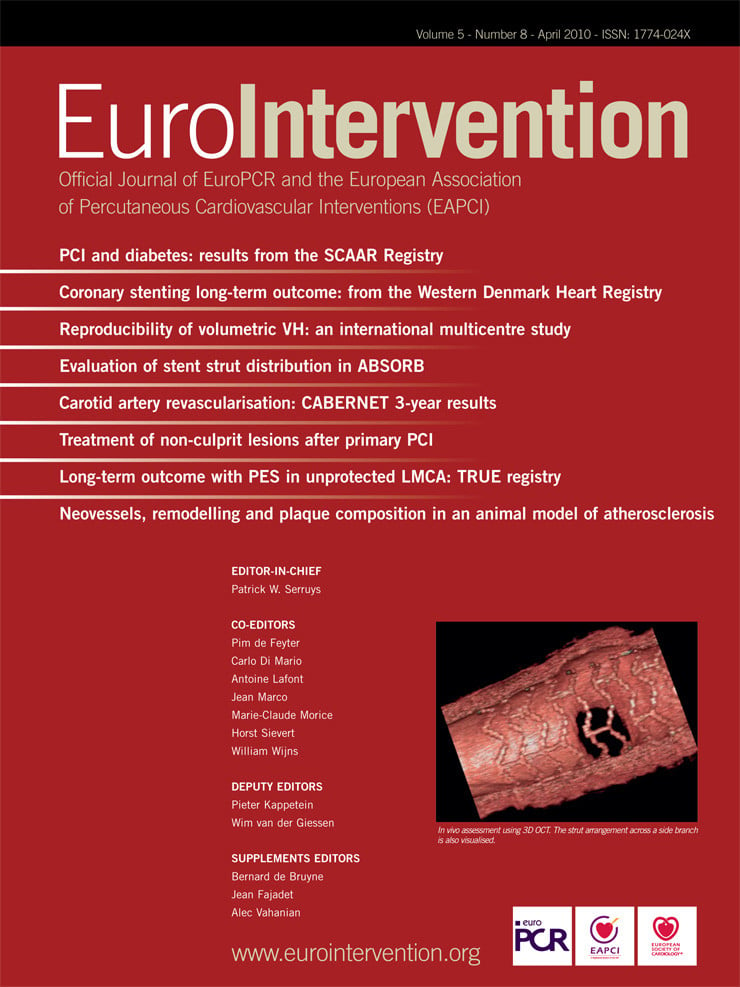Chronic total occlusions (CTOs) are frequently encountered during diagnostic coronary catheterisation. However, there is still confusion regarding the indication for percutaneous coronary intervention (PCI) in this lesion subset, mainly because it is cumbersome and the prognostic impact of revascularisation in these patients remains unclear. Many studies have now shown the long term clinical benefits after CTO PCI1-3; still, with procedural complexity, high radiation exposure to both the patient and the operator, high costs and lower procedural success rates, most patients with CTO are managed medically or referred for bypass graft surgery – regardless of the severity of symptoms and extent of ischaemia4.
It is for these reasons that 15 dedicated European CTO operators established the EuroCTO Club in 20065, modelled on similar initiatives in Japan and the USA, whereby members share their experience both within the group and with the interventional and the general cardiology communities at large. The current president of the club is Nicolaus Reifart (Bad Soden, Germany) and the board includes Alfredo R. Galassi (Catania, Italy), George Sianos, (Thessaloniki, Greece) Gerald S. Werner (Darmstadt, Germany) and Hans Bonnier (Brussels, Belgium). Since 2007, the club is active in the field of research, teaching and promoting CTO PCI, which in many European countries is still the main indication for referring patient to bypass surgery. As of last October 2009, 35 new members joined the club. These members, coming from all over Europe, including Turkey, each had a personal experience of 300 CTO procedures and an annual experience of at least 50 CTO procedures.
Highlights from first course “Experts live”
Surrounded by the wonderful scenery of Taormina on October 30 and 31 2009, the first scientific meeting of the EuroCTO club was launched.

Figure 1. The ECC board members and Prof C. Di Mario. From left to the right: G. Werner, C. Di Mario, H. Bonnier, G. Sianos, C. Refairt (President of the ECC) and A. Galassi.
The course faculty consisted of world experts in CTO, including the most experienced Japanese and American operators, who presented state-of-the-art lectures, providing very interesting and didactic “live-taped” cases. These were discussed interactively, with the entire audience participating in lively discussions as well as structured polls using the provided tele-voting system. Almost 300 attendees from 12 European countries participated in the course, with a poll revealing that more than 75% of the attendees were highly experienced PCI operators, with considerable expertise in treating CTOs. The opening ceremony, presided by the course director Alfredo R. Galassi, started with a tribute to Andreas Gruentzig with the projection of an exclusive original interview of by Burt Cohen, only weeks before Andreas’ tragic plane crash. In this interview it is impressive how well Andreas Gruentzig predicted so much of the field’s future concerns about complex PCI, underlining almost 25 years ago that “if we cannot solve the total occlusion problem, we will probably never really address the question of multivessel disease dilatation.”
After the opening ceremony on Friday, October 30, the session began with a trenchant lecture about the rationale for CTO revascularisation by J. R. Margolis, who highlighted the benefits of CTO PCI in cases of appropriate patient selection. During the first day, several live taped cases of varying complexity were presented by EuroCTO club members including A.R. Galassi, A. Gershlick, J. Escaned, N. Reifart, G. Olivecrona, C. Di Mario, A. Serra and G. Sianos. These cases were of various difficulty levels, which were explained and discussed before starting each procedure, as well as the varying angiographic features, such as the presence of a stump at the entry point, length of occlusion, distal vessel visualisation, bridging collaterals, calcifications, tortuosity of the occlusion, etc. After these discussions, each operator selected the most appropriate strategy based on his expertise and personal preferred approach. The audience and expert panellists were interactively involved in the case presentation by tele-voting on specific “key points” submitted step-by-step during the live case by the case presenter.
The major findings drawn were:
– When dealing with the retrograde approach, wire externalisation can be applied successfully, although its use is not yet standardised even among experts. O. Katoh suggested the development of a new specific, dedicated wire that could overcome the drawback of Rota-wire and conventional 300 cm wires for externalisation.
– Multislice computed tomography (MSCT) was deemed useful to visualise the take-off, length and course of occlusions.
– Stiff and tapered spring wires were discussed in detail, and upon appropriate use, they were considered less dangerous then expected by the participants.
– Bifurcations within a CTO are an important consideration as sometimes bifurcation stenting appears necessary.
In the following series of lectures, B.H. Strauss illustrated new developments in micro-channel detection by micro-magnetic resonance imaging and MSCT, as well as collagenase use in an animal model, to improve crossing of experimental CTOs with guidewires. M. Ochiai explained the Japanese state-of-art for antegrade techniques, underlining the importance of IVUS use for procedure guidance. Since IVUS is rarely reimbursed in Europe, the Club operators favour techniques like the parallel and triple wire technique, as well as angiographically driven re-entry from a subintimal space, instead of IVUS-guided re-entry. Finally, C. Thompson presented an overview of a new dedicated device for CTO PCI, focussing on the Crosser System, the Stingray System and retrograde Stent-application, first described by G. Sianos, to ease reversed CART- technique.
Saturday, October 31 saw two thrilling lectures from E. Tsuchikane and O. Katoh dealing with the retrograde approach: basic concepts, current status and future developments. Their convincing presentations focussed on the dedicated septal channel dilator Corsair® that has revolutionised the CART and reverse IVUS-enhanced CART technique, now preferred by Japanese specialists. The session continued with live recorded cases by the club members including T. Lefevre, A.R. Galassi, N. Reifart, W. Lombardi, G.S. Werner, G. Sianos who, like W. Lombardi the day before, described his bold retrograde stent deployment in detail. The topics discussed in greater detail were:
– The Stingray system, a double channel balloon catheter that allows re-entry from the false to the true lumen, in the case of a long CTO of the right coronary artery.
– The promising technique of new tapered polymeric guidewires (Fielder XT®) as a first step in CTO.
– The usefulness of often existing, but invisible micro-channels, for the antegrade approach (again an indication for the Fielder XT).
– The feasibility of saphenous grafts reopening by the retrograde approach and the use of embolic protection devices during these complex procedures.
– The possibility that long spiral dissections may seal spontaneously after 30 days, thus enabling rather easy and successful recanalisation with a second approach.
A. Manari, a renowned expert of renal disease, addressed a very important issue of CTO recanalisation, stressing the concept of pre-treatment with fluid in order to reduce contrast induced nephropathy. As always, complications caught the attention of the audience. It is no surprise that Y. Asakura received major attention from the participants when he spoke about procedural related complications such as coronary rupture, no-reflow after CTO recanalisation and an exceptional case of septal haematoma due to blood extravasation during the retrograde approach. O. Katoh added, and demonstrated, that with success rates of up to 95%, more and more CTOs include small, diffusely diseased vessels, leading to nastier perforations and restenosis.
The workshop was concluded with a live taped presentation of several procedural complications by the club members C. Di Mario, A.R. Galassi and G. Sianos who showed a unique case of Corsair entrapment during the retrograde approach, leading to an emergency CABG.
The scientific meeting was followed by the EuroCTO club’s general assembly, with the report of the chairman, treasurer and course director, as well as a discussion and implementation of rules for membership (300 historical CTO procedures, 50 annual procedures and the recommendations of at least two board members). Moreover, A.R. Galassi announced officially the Club’s website (www.eurocto.eu) and presented preliminary data of the web based European Registry of CTO (ERCTO) (www.ercto.eu) where every club member will register their CTO cases including all procedural and patients characteristics as well as outcomes at one, two and three years. Finally, the status of the EuroCTOs ambitious trial to prove prognostic impact of CTO revascularisation in a multicentre European randomised study was discussed.
This meeting proved to be a fascinating interaction between the worlds’ leading experts in the field of percutaneous revascularisation of CTOs and a mostly experienced audience from all over Europe. The feedback of participants and industry was overwhelming. A follow-up meeting was announced, to be organised in October 2010 in Greece.

